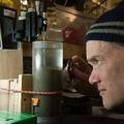
Article
Effects of Zostera marina rhizosphere and leaf detritus on the concentration and distribution of pore-water sulfide in marine sediments
Estuarine, Coastal and Shelf Science
(2018)
Abstract
The relationship between seagrasses and pore-water hydrogen sulfide in the sediment is complex due to the opposing effects of the seagrass root system, which can reduce sulfide concentration by promoting its oxidation to sulfate, and the burial of organic matter from the plant itself, which can increase sulfide concentration by stimulating anaerobic sulfate reduction. Here, field samples of pore-water sulfide were collected in areas with and without Zostera marina shoots using Diffusive Gradients in Thin-Films (DGTs) to obtain two-dimensional visualizations of sulfide concentrations within the sediment in relation to location of eelgrass detritus and the rhizosphere. To decouple the effects of leaf detritus and the eelgrass rhizosphere on sulfide, manipulative laboratory studies were conducted over 4 weeks using 10 aquaria with or without eelgrass and different quantities of eelgrass detritus planted at 4 cm and 11 cm depths. Spatial distribution of pore-water sulfide was again measured via DGT. We found high spatial variation in pore-water sulfide concentration depending on the location analyzed relative to the rhizosphere or detritus. In the field study, pore-water sulfide concentration was greater in samples with eelgrass present, and the presence of leaf detritus accounted for higher than average sulfide concentrations in the sediment. In the laboratory experiment, sulfide concentrations localized around the leaf detritus increased with higher mass of added detritus, and sediment within the rhizosphere exhibited reduced sulfide concentrations. These results suggest that on the large scale the presence of eelgrass increases sulfide concentration, but on the smaller scale the pattern varies, with higher concentrations near buried detritus and lower concentrations near root tips.
Keywords
- Seagrass rhizosphere,
- Seagrass detritus,
- Sulfate reduction,
- Sulfide,
- Iron,
- Diffusive gradients in a thin film (DGT),
- Sediment chemistry
Disciplines
Publication Date
September 30, 2018
DOI
https://doi.org/10.1016/j.ecss.2018.05.024
Publisher Statement
© 2018 Elsevier Ltd. All rights reserved.
Citation Information
David H. Shull, Alexandra G. Simpson, Laura Tripp and Sylvia Yang. "Effects of Zostera marina rhizosphere and leaf detritus on the concentration and distribution of pore-water sulfide in marine sediments" Estuarine, Coastal and Shelf Science Vol. 209 (2018) p. 160 - 168 Available at: http://works.bepress.com/david_shull/16/
